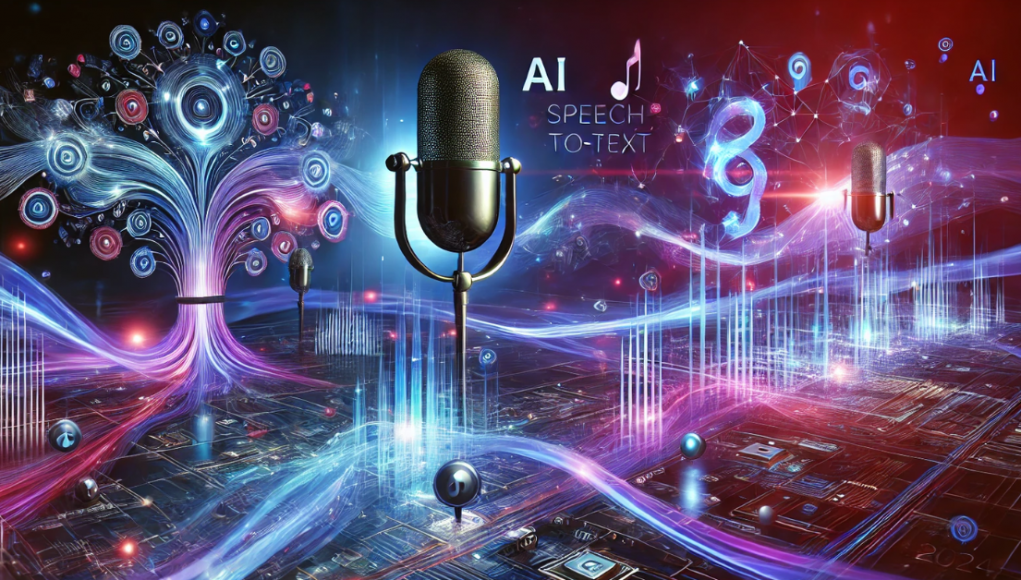In today’s fast-paced digital landscape, the ability to convert spoken words into text—known as speech-to-text (STT)—has become indispensable for businesses and individuals alike. Whether you’re transcribing meetings, developing voice-activated apps, or enhancing accessibility, choosing the right from the Top AI Speech-to-Text Solutions is crucial. However, with so many options available, selecting the best one can be daunting.
This guide offers an in-depth exploration of the top AI speech-to-text solutions available in 2024. We will discuss what makes these tools exceptional, how they work, and which might be the best fit for your needs.
What is a Speech-to-Text Solution?
A speech-to-text (STT) solution is a technology that converts spoken language into written text. Using advanced algorithms and often powered by artificial intelligence (AI), STT solutions are critical in various applications—from virtual assistants to automated customer service, content creation, and beyond. By turning spoken language into text, STT solutions facilitate easier data analysis, improved accessibility, and streamlined communication.
Why is Choosing the Right Speech-to-Text Solution Important?
Selecting the appropriate STT solution is vital because it directly impacts the accuracy and efficiency of your operations. A solution that delivers inaccurate or slow transcriptions can lead to misunderstandings, costly errors, and a decrease in productivity. Conversely, a high-quality STT solution can enhance productivity, boost customer satisfaction, and drive innovation in your business processes.
Key Factors to Consider When Choosing an AI Speech-to-Text Solution
When choosing an AI speech-to-text solution, several critical factors should be taken into account to ensure you select the right tool for your specific needs:
1. Accuracy
Accuracy is the most critical factor in evaluating an STT solution. Accurate transcription is essential, especially in professional settings where even minor errors can have significant consequences. The accuracy of an STT system is often measured using the Word Error Rate (WER), where a lower WER signifies higher accuracy. The best STT solutions can handle complex language structures, various accents, and noisy environments effectively.
2. Speed
Speed is another essential factor, particularly for real-time applications such as voice assistants, live captions, or customer support chatbots. A good STT solution should process speech quickly, providing minimal latency to ensure a seamless and responsive user experience. Fast processing speeds also allow for more efficient batch processing, saving time and resources.
3. Cost
Cost-effectiveness is crucial, especially for businesses that require large-scale transcription services. The pricing models for STT solutions vary widely, with some offering competitive rates for bulk usage and others providing premium features at a higher cost. It’s essential to consider both the initial cost and the long-term return on investment (ROI) when selecting an STT solution.
4. Language Support
If your business operates in multiple regions or deals with a multilingual audience, language support is a key consideration. Some STT solutions specialize in English, while others offer extensive support for a wide range of languages and dialects. Even if you currently only need one language, choosing a solution with robust multilingual capabilities can future-proof your investment.
5. Customization
Customization allows you to tailor the STT solution to meet your specific needs. This can include training the model on industry-specific terminology, adapting it to particular accents, or integrating it seamlessly with your existing systems. Customization is especially important for industries with specialized jargon or unique requirements, such as legal, medical, or technical fields.
6. Ease of Integration
Ease of integration is a vital factor, particularly for developers and businesses looking to embed STT capabilities into their applications. The best STT solutions offer easy-to-use APIs, comprehensive documentation, and strong customer support. A smooth integration process can save time and reduce development costs, making it easier to deploy the STT solution across your platforms.
7. Scalability
Scalability is crucial if you plan to expand your use of Top AI Speech-to-Text Solutions services over time. A scalable solution can handle increasing volumes of data without compromising performance. This is particularly important for growing businesses or those with fluctuating transcription needs.
Top AI Speech-to-Text Solutions in 2024
Let’s delve into the top AI speech-to-text solutions of 2024, examining their strengths, weaknesses, and ideal use cases.
1. Deepgram
Deepgram is recognized as one of the leading STT solutions, offering high accuracy and speed. It employs end-to-end deep learning models, ensuring top-notch performance across various applications. Deepgram supports both real-time and batch processing, making it versatile for different use cases, from live captioning to large-scale transcription tasks.
Pros:
– Exceptional accuracy, even in challenging environments
– Fast processing times for both real-time and batch transcriptions
– Supports multiple languages, with ongoing updates to include more
– Offers customizable models for industry-specific needs
– Developer-friendly with comprehensive API documentation
Cons:
– Fewer languages supported compared to some competitors, but new languages are regularly added
– Higher cost for custom solutions, though ROI is generally strong
Best For:
Deepgram is ideal for businesses that prioritize accuracy and need a customizable solution. It’s particularly well-suited for real-time applications, such as live transcription, voice assistants, or customer support systems where responsiveness is key.
2. OpenAI Whisper
OpenAI Whisper is an open-source STT solution, known for its flexibility and extensive language support. It’s designed to handle a wide range of speech tasks, including transcription and translation, making it a versatile option for developers and researchers.
Pros:
– Supports a wide array of languages, including less common ones
– Open-source and highly customizable
– High accuracy for supported languages and tasks
– Ideal for experimentation and custom projects
Cons:
– Slower processing speeds, particularly with larger models
– Limited real-time capabilities without extensive customization
– Requires significant computing resources, which can increase costs
Best For:
OpenAI Whisper is a great choice for researchers, developers, and organizations looking for a flexible, open-source solution. It’s best suited for non-real-time applications where language diversity and customization are top priorities.
3. Microsoft Azure Speech-to-Text
Microsoft Azure’s STT service is part of the Azure Cognitive Services suite, offering a robust and scalable solution that integrates seamlessly with the Azure ecosystem. This makes it a strong contender for businesses already using Microsoft’s cloud services.
Pros:
– Good transcription accuracy across various environments
– Supports both real-time and batch processing
– Extensive language support with ongoing improvements
– Seamless integration with Azure’s cloud services and other tools
– High scalability, making it suitable for enterprises
Cons:
– Higher cost, especially for enhanced models or large-scale usage
– Slower processing speeds for pre-recorded audio
– Limited customization options compared to specialized providers
Best For:
Microsoft Azure Top AI Speech-to-Text Solutions is ideal for enterprises already invested in the Microsoft ecosystem. It’s well-suited for applications requiring tight integration with Azure services, such as large-scale enterprise solutions or projects that leverage multiple Azure tools.
4. Google Cloud Speech-to-Text
Google Cloud Speech-to-Text offers a reliable STT service with strong language support and seamless integration with Google’s cloud platform. It’s a popular choice for businesses that already rely on Google Cloud for their operations.
Pros:
– Extensive language support, making it suitable for global applications
– Real-time transcription capabilities, essential for live applications
– Strong integration with Google Cloud services, enhancing workflow efficiency
– Scalable and secure, suitable for large enterprises
Cons:
– Accuracy is not as high as some leading competitors
– Slower processing speeds for pre-recorded audio, which can be a bottleneck for large files
– Higher costs for enhanced models, especially when data logging is opted out
Best For:
Google Cloud STT is a solid choice for businesses that are already using Google Cloud services. It’s particularly useful for applications that require multilingual support and need to transcribe speech in real-time, such as in customer service or international media.
5. Amazon Transcribe
Amazon Transcribe is part of the AWS suite, offering a robust STT service with support for real-time and batch processing. It’s designed to integrate seamlessly with other AWS services, making it a natural choice for businesses already using AWS.
Pros:
– Reliable transcription accuracy, especially for pre-recorded audio
– Supports multiple languages and dialects
– Real-time streaming capabilities, crucial for live applications
– Integration with AWS ecosystem, providing scalability and security
Cons:
– Higher costs, particularly for medical transcriptions or enhanced models
– Limited customization options, which may not suit specialized industries
– Slower processing speed compared to some top competitors
Best For:
Amazon Transcribe is best suited for businesses that are part of the AWS ecosystem and need a reliable STT service with strong language support. It’s particularly useful for large-scale applications that require the robust infrastructure provided by AWS.
6. AssemblyAI
AssemblyAI is a developer-focused STT service that offers a comprehensive feature set, including speaker diarization, sentiment analysis, and topic detection. It’s designed for ease of use, making it a popular choice for developers building AI-powered applications.
Pros:
– Developer-friendly with robust APIs and easy integration
– Strong feature set, including advanced capabilities like sentiment analysis
– Decent accuracy and processing speed, suitable for various applications
– Supports multiple languages, making it versatile for global use
Cons:
– Middle-of-the-road accuracy compared to top-tier providers
– Limited customization options, which may not meet the needs of specialized industries
– Higher cost for advanced features, which can increase overall expenses
Best For:
AssemblyAI is ideal for developers and businesses looking for a feature-rich STT service that is easy to integrate into their applications. It’s a good choice for building AI-powered products that require advanced transcription capabilities.
7. Rev AI
It is an automated transcription service offered by Rev.com, known for its human transcription services. Rev AI offers automated STT services with additional features such as sentiment analysis and topic detection, making it a powerful tool for media and content creators.
Pros:
– High accuracy for specific use cases like podcasts, video content, and media
– Feature-rich, including speaker diarization and sentiment analysis
– Faster processing speed compared to many competitors
– Integration with other Rev services, providing a seamless workflow
Cons:
– More expensive than many other automated STT solutions
– Limited real-time capabilities, which may be a drawback for live applications
– Poor accuracy for non-English languages, limiting its global applicability
Best For:
Rev AI is best for businesses that focus on media content, such as podcasts, video production, or online publishing, where accuracy and speed are critical. It’s particularly well-suited for industries that need high-quality transcriptions of English content.
8. Speechmatics
Speechmatics is a UK-based STT solution provider, with a focus on British English and other non-English languages. It’s known for its good performance with British accents and offers on-premises deployment options, making it suitable for industries with stringent security requirements.
Pros:
– Strong performance with British accents and UK-specific spellings
– Extensive support for non-English languages, making it suitable for global businesses
– On-premises deployment options for enhanced security and compliance
– Good accuracy for specific accents and languages
Cons:
– Higher cost compared to other STT solutions
– Slower processing speed, which can be a drawback for time-sensitive projects
– Limited customization options, which may not meet the needs of all businesses
Best For:
Speechmatics is ideal for businesses in the UK or those needing strong support for British accents and non-English languages. It’s particularly useful for industries with strict data security requirements that prefer on-premises deployment.
9. IBM Watson Speech-to-Text
IBM Watson was one of the early pioneers in AI and STT technologies. Although it has been outpaced by newer solutions, IBM Watson Speech-to-Text still offers a robust transcription service with good language support and integration with IBM’s AI and cloud services.
Pros:
– Strong brand recognition, providing credibility and trust
– Supports multiple languages, making it suitable for international use
– Integrates seamlessly with IBM’s AI and cloud services, offering a comprehensive solution
– Offers advanced features like speaker diarization and word-level timestamps
Cons:
– Poor accuracy compared to newer STT solutions, especially in noisy environments
– Expensive, with a pricing model that may not suit smaller businesses
– Slower processing speed, which can delay project timelines
– Limited customization options, making it less flexible for specific needs
Best For:
IBM Watson STT is suitable for businesses already using IBM’s AI or cloud services, particularly those with existing investments in IBM technology. It’s a good choice for enterprises needing a reliable STT solution that integrates with other IBM tools.
10. Kaldi
Kaldi is an open-source speech recognition toolkit that has been widely used in academic research and experimental applications. While it’s not a ready-made STT solution, Kaldi is highly customizable, making it a powerful tool for developers and researchers with the technical expertise to tailor it to their needs.
Pros:
– Open-source and free to use, making it accessible to researchers and developers
– Highly customizable, allowing for tailored solutions based on specific requirements
– Strong community support, with extensive documentation and resources available
– Ideal for experimentation and academic research
Cons:
– Requires significant technical expertise to implement and customize
– Poor real-world accuracy without extensive training on relevant data
– Slow processing speed due to its architecture, which can hinder real-time applications
– No built-in customer support, requiring users to rely on community forums and documentation
Best For:
Kaldi is best for researchers, developers, and organizations that have the technical expertise to build and customize their own STT solutions. It’s particularly well-suited for academic research, experimentation, and projects where customization is more important than out-of-the-box functionality.
Conclusion: Choosing the Best AI Speech-to-Text Solution for Your Needs
Selecting the best AI speech-to-text solution depends on your specific needs, including the required accuracy, speed, language support, and budget. Here’s a quick summary to help you decide:
– For the highest accuracy and speed: Choose Deepgram. It offers industry-leading performance, making it ideal for real-time applications and large-scale projects.
– For open-source flexibility: Go with OpenAI Whisper or Kaldi. These solutions are highly customizable and ideal for developers and researchers looking to experiment with STT technologies.
– For seamless integration with cloud services: Microsoft Azure, Google Cloud, or Amazon Transcribe are strong contenders, especially for businesses already invested in these ecosystems.
–For developer-friendly features: Consider AssemblyAI or Rev AI. These platforms offer robust APIs and advanced features that make them ideal for building AI-powered applications.
– For specialized language support: Speechmatics is the best choice, particularly if you need strong support for British accents or non-English languages.
No matter which solution you choose, ensure it aligns with your business goals and technical requirements. By carefully considering the factors outlined in this guide, you can select the best STT solution to drive your success in 2024 and beyond.





